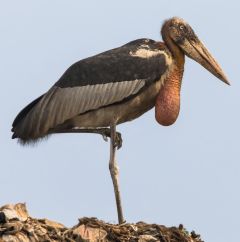That would be the Hargila [R standing on top of a landfill] the greater adjutant stork Leptoptilos dubius. The head and neck of the adult birds are featherless because, like vultures for a similar reason, it's easier to keep clean that way. As carrionistas, they used to spend a fair bit of their time plunged shoulder deep in an animal carcass, for dinner, like. Not so much nowadays, as it's easier to make a living scavenging at the landfill outside town. Where the birds have a truce with the scavenging humans looking for the match to a discarded shoe or anything that can be traded for food. It is perhaps mutually beneficial as the people are more efficient at turning over each ten tonne truckload of fresh trash; but they aren't so keen on a chicken carcass when it's been mixed with glark! who knows what. The huge flaccid neck scrotum is used to make attractive sounds during the mating season.
I knew next to nothing about these birds and the near fatal change in their circumstances in my life time until I was induced to watch Hargila a 30 min filum by Gerrit Vyn from the Cornell Lab for Ornithology.
Pandas (Ailuropoda melanoleuca), Indian rhinos (Rhinoceros unicornis) and tigers (Panthera tigris) attract a disproportionate amount of the limited conservation dollars . . . because you can market a soft-toy out of any of those species.

No comments:
Post a Comment